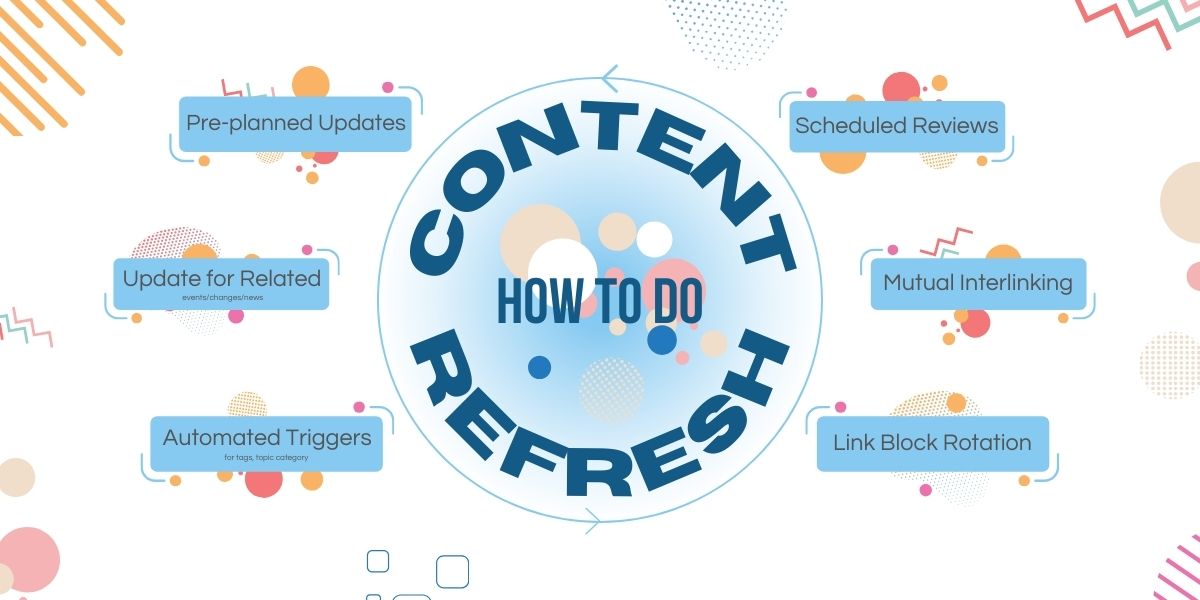Content Refresh: How to Plan and Update Old Content for Better Rankings

Keeping your website content relevant, accurate, and engaging for your audience helps you get love from both search engines and users. If done right, content refresh or updating old content can give a huge push to the rankings. You don’t need to delete old content; just tweak it to keep the content helpful.
Finding the right article to update and identifying the appropriate keywords cannot be achieved in a simple moment of inspiration over a cup of tea. Refreshing content requires a strategic plan, self-control, and a thorough comprehension of the relevant data and subject matter.
That is why insignificant cheat changes like:
- Altering the title
- Tweaking the h1
- Changing the “publish date”
And similar stuff is just lazy work and nothing more than a shot in the dark. It may work, but it’s an easy-come, easy-go situation. You may find many articles and videos to support these hacky lazy changes, but when you read Google’s guidelines for helpful content, you’ll see that the hacks don’t always work.
If you came here looking for such hacks to rank content quickly, Sorry, I have none. What I’ll share today are solid suggestions that will require you to do additional content/changes. (from the writing to editing process!)
- Add a little content
- Remove a little content
- A little re-organisation of sentences
- A tweak to a term/phrase
- Add a quote or citation
For some content, it can be bigger updations, such as
- Updates to figures,
- New dates for confirmed events/showings,
- Updates on attendance, etc.
People seem to forget that online content is “living pages”, not stone-engraved scriptures. And Google does seem to reward such pages with better and more sustainable rankings.
Related Read: How to optimize your blog like a Pro!!
If you are ready to pull your leg and do some solid work here’s how to plan and update old content for better rankings.
7 Ways to Update Old Content for Better Rankings

1. Have Pre-planned Updates and Dates to Update:
Persistence and punctuality play a key role in deciding the success rate of any work. To make your content refresh successful, create a content calendar and schedule dates for updating specific pieces of content. Ensure content is reviewed and refreshed according to a predetermined schedule. This will save your content from being outdated.
2. Have Scheduled Reviews:
Having a calendar marked for updates and doing a review are two different things. The world is full of unpredictable incidents, and if your content is related to that incident it should comply with the same. Scheduled reviews involve periodically revisiting your existing content to check for outdated information, broken links, or areas that need improvement(like just another day for SEOs). Do it regularly to keep your content up-to-date and helpful.
Read: SEO 101
3. Have 'Trigger Terms' (for events/changes/news/trends etc.):
These trigger terms are specific keywords or phrases that signal the need for content updates when certain events or changes occur. Monitoring these terms allows you to identify when content needs to be updated to reflect the latest developments.
For example, if you’re writing about a new product that’s coming out soon, you might use “trigger terms” like “release date” or “price” to let you know when you need to update your content with the latest information.
4. Have 'Trigger Terms' for Existing Content and Mutual Inter-linking:
Use trigger terms for existing content to identify when existing content needs to be updated with the latest information. It involves interlinking related pieces of content within your website to improve user navigation and increase the visibility of older articles.
You can use Google Analytics to track user behaviour on your website and identify which pages need updating or interlinking. Also, ensure that any freshly published content is linked to relevant existing articles and vice versa.
5. Have a 'Rotation' in Certain Link Blocks, Shown on 'Ancestor' Pages:
Have specific links on pages that are higher in the hierarchy (ancestor pages) on a rotational basis. These links could be to popular or evergreen content. The rotation helps users explore that content and bump traffic.
6. Have Tags/Triggers for 'Related Links' Blocks (automated by category/topic/taxonomy etc.):
In addition to manually interlinking content, you can use automated systems based on tags or triggers to display related links on a page. This will ensure that the content is relevant to the user’s interests and browsing patterns.
For example, you can show blogs of a particular category on that category’s service page or product pages of that category.
7. Plan Promotion and Re-promotion Actions on Social Media:
You can’t wait for traffic inflow till Google starts ranking your updated content. Having planned promotion actions, such as sharing content on social media platforms like Twitter(Now X), helps to drive traffic and engagement to your content.
Re-promotion, either automated or for manual selection to repost after N days/weeks/months, helps to bring attention back to valuable evergreen content that may have been overlooked initially. Don’t shy away from sharing older but still relevant content again with your audience. Social media is overwhelmed with content, and there are high chances that your content may have gone unnoticed the first time. Reshare your content with different captions/infographics/images.
Bonus: Have promotional 'Trigger Terms' (for specific events, news, trends, etc.):
Good content is never dead. Just because you lost active traffic on some content doesn’t mean the content is obsolete. Maybe the interest of people is lost in it. Similarly, every day there’s something new trending on social media, but not every time it is a new topic. Most of the time it’s an old topic coming back in trend.
If you see a keyword or phrase related to your old content, re-promote your content. This helps to align your content promotion with relevant topics that are currently popular or trending.
To summarise it all, content refresh is an integral part of Good SEO which involves updating, interlinking, and promoting your content strategically to ensure it remains valuable and engaging to your audience. If you can keep all website content useful for users, you won’t need to delete old content. And you can continue to reap quality traffic from all pieces of content on your website.

Recommended Posts

Why Your Website Is Your Secret Weapon
September 4, 2024

SEO vs SEM: How SEM Help With SEO?
April 15, 2024


